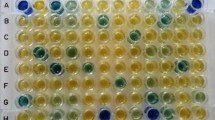Abstract
Rhizoferrin-mediated iron uptake was studied in two different classes of organisms: a rhizoferrin producing fungus, Absidia spinosa (Zygomycetes), and a ferric rhizoferrin utilizing bacterium, Morganella morganii (Enterobacteriaceae). The uptake of iron rhizoferrin and some of its metal analogs (chromium, rhodium, gallium), was followed and kinetic parameters measured in A. spinosa. These metal ion complexes were taken up in a concentration- and energy-dependent manner indicative of an active transport system. The uptake of the kinetically inert chromium and rhodium and reductively inert gallium complexes suggests a variation of the so called ‘shuttle’ mechanism may be operative. The recognition of one geometrical isomer of chromium-rhizoferrin but not another argues for a degree of stereospecificity in the uptake process. A growth promotion plate assay was used to examine metal-rhizoferrin uptake in M. morganii. The results indicate that a number of factors including the nature of the chelating agent (e.g. bipyridyl or EDDHA) used to induce iron deficiency need to be considered before these simple plate assays can be reliably used to indicate the presence or absence of a particular siderophore uptake system.
Similar content being viewed by others
References
Carrano CJ, Drechsel H, Kaiser D, Jung G, et al. 1996 The coordination chemistry of the carboxylate type siderophore rhizoferrin: the iron (III) complex and its metal analogs. J Am Chem Soc, submitted.
Chung TY, Matzanke BFM, Winkelmann G, Raymond, KM. 1986 The inhibitory effect of the partially resolved coordination isomers of chromic desferricoprogen on coprogen uptake in Neurospora crassa. J Bacteriol 165, 283–287.
Drechsel H, Metzger J, Freund S, Jung G, Boelaert JR, Winkelmann G. 1991 Rhizoferrin-a novel siderophore from the fungus Rhizopus microsporus var. rhizopodiformis. BioMetals 4, 238–243.
Drechsel H, Jung G, Winkelmann G. 1992 Stereochemical characterization of rhizoferrin and identification of its dehydration products. BioMetals 5, 141–148.
Drechsel H, Thieken A, Reissbrodt R, Jung G, Winkelmann G. 1993 α-Keto acids are novel siderophores in the genera Proteus, Providencia and Morganella and are produced by amino acid deaminases. J Bacteriol 175, 2727–2733.
Ecker DJ, Loomis LD, Cass ME, Raymond KN, 1988 Substituted complexes of enterobactin and synthetic analogs as probes of the ferric enterobactin receptor. J Am Chem Soc 110, 2457–2459.
Huschka H, Naegeli HU, Leuenberger-Ryf H, Keller-Schierlein W, Winkelmann G. 1985 Evidence for a common siderophore transport system but different siderophore receptors in Neurospara crassa. J Bacteriol 162, 715–721.
Kühn S. 1995 Rhizoferrin-Aufnahme in Morganella morganii. Dissertation thesis, University of Tübingen.
Matzanke BF. 1994 Iron storage in fungi. In: Winkelmann G, Winge DR, eds. Metal Ions in Fungi. New York: Marcel Dekker; 179–214.
Thieken A, Winkelmann G. 1992 Rhizoferrin: a complexone type siderophore of the Mucorales and Entomophthorales (Zygomycetes). FEMS Microbiol Lett 94, 37–42.
Thieken A, Winkelmann G. 1993 A novel bioassay for the detection of siderophores containing keto-hydroxy bidentate ligands. FEMS Microbiol Lett 11, 281–286.
Van der Helm D, Winkelmann G. 1994 Hydroxamates and polycarboxylates as iron transport agents (siderophores) in fungi. In: Winkelmann G, Winge DR, eds. Metal Ions in Fungi, New York: Marcel Dekker; 39–98.
Winkelmann G. 1992 Structures and functions of fungal siderophores containing hydroxamate and complexone type iron binding ligands. Mycol Res 96, 529–523.
Author information
Authors and Affiliations
Rights and permissions
About this article
Cite this article
Carrano, C.J., Thieken, A. & Winkelmann, G. Specificity and mechanism of rhizoferrin-mediated metal ion uptake. Biometals 9, 185–189 (1996). https://doi.org/10.1007/BF00144624
Received:
Accepted:
Issue Date:
DOI: https://doi.org/10.1007/BF00144624




